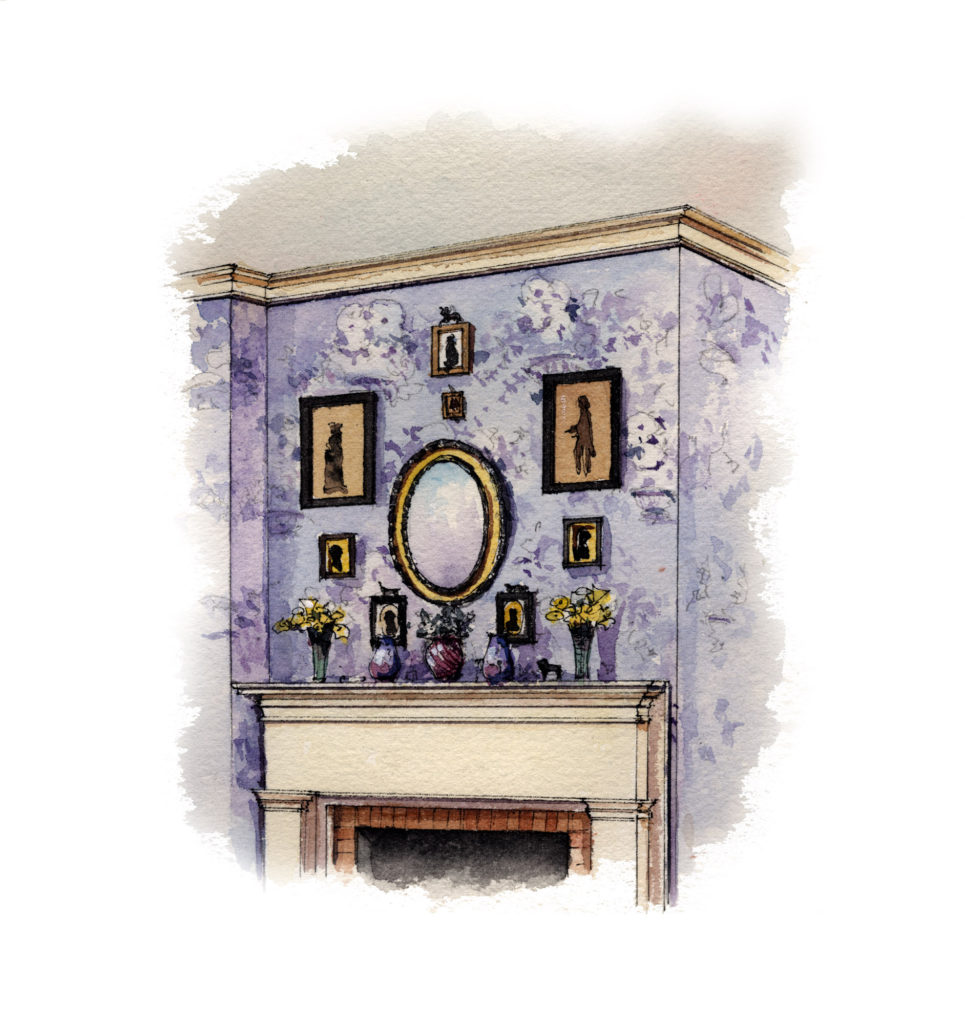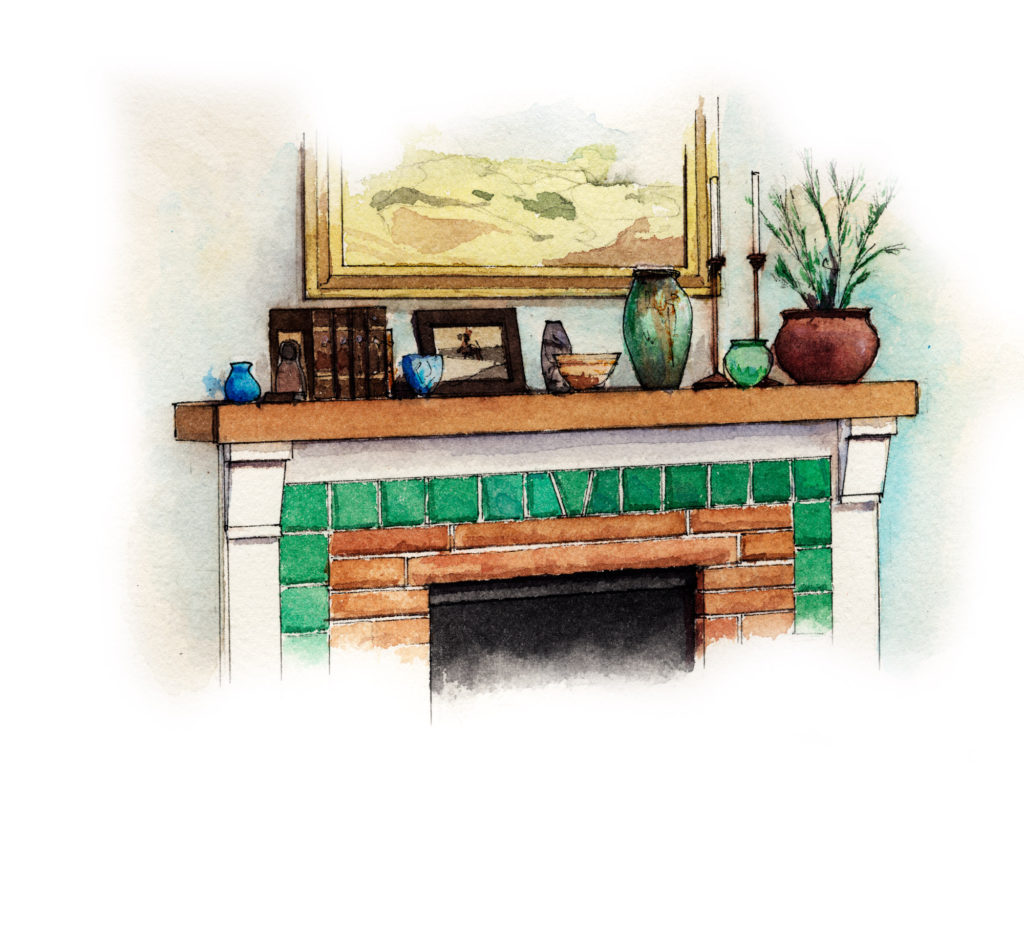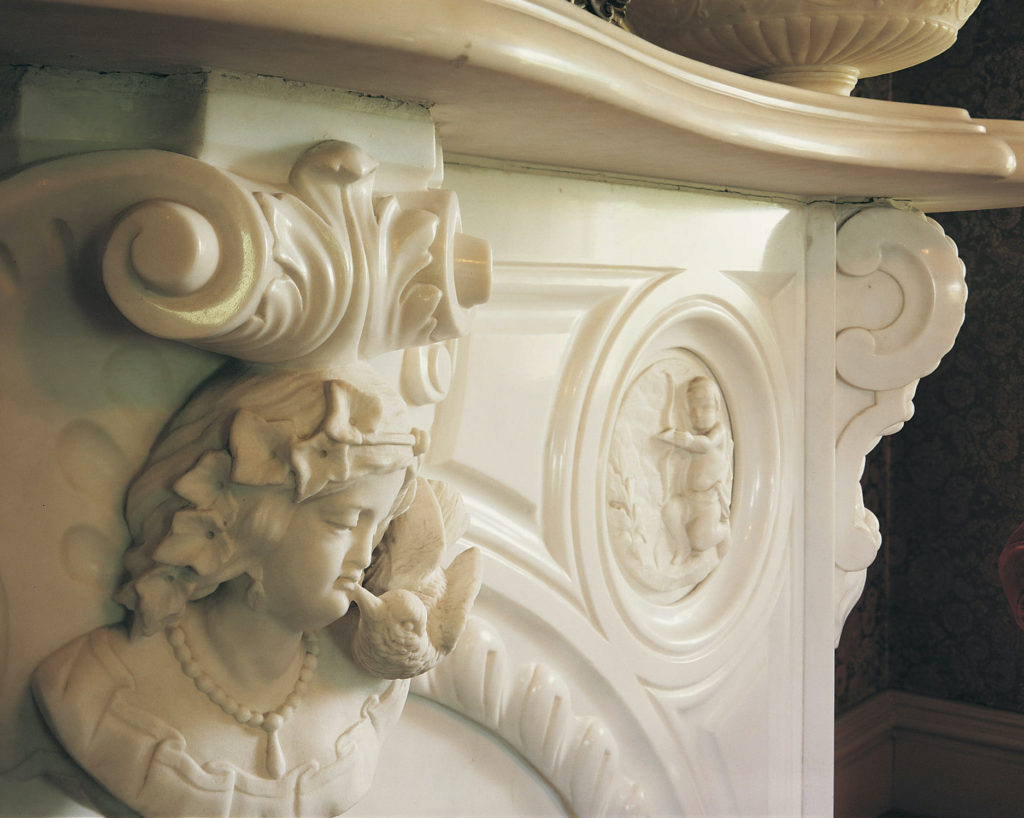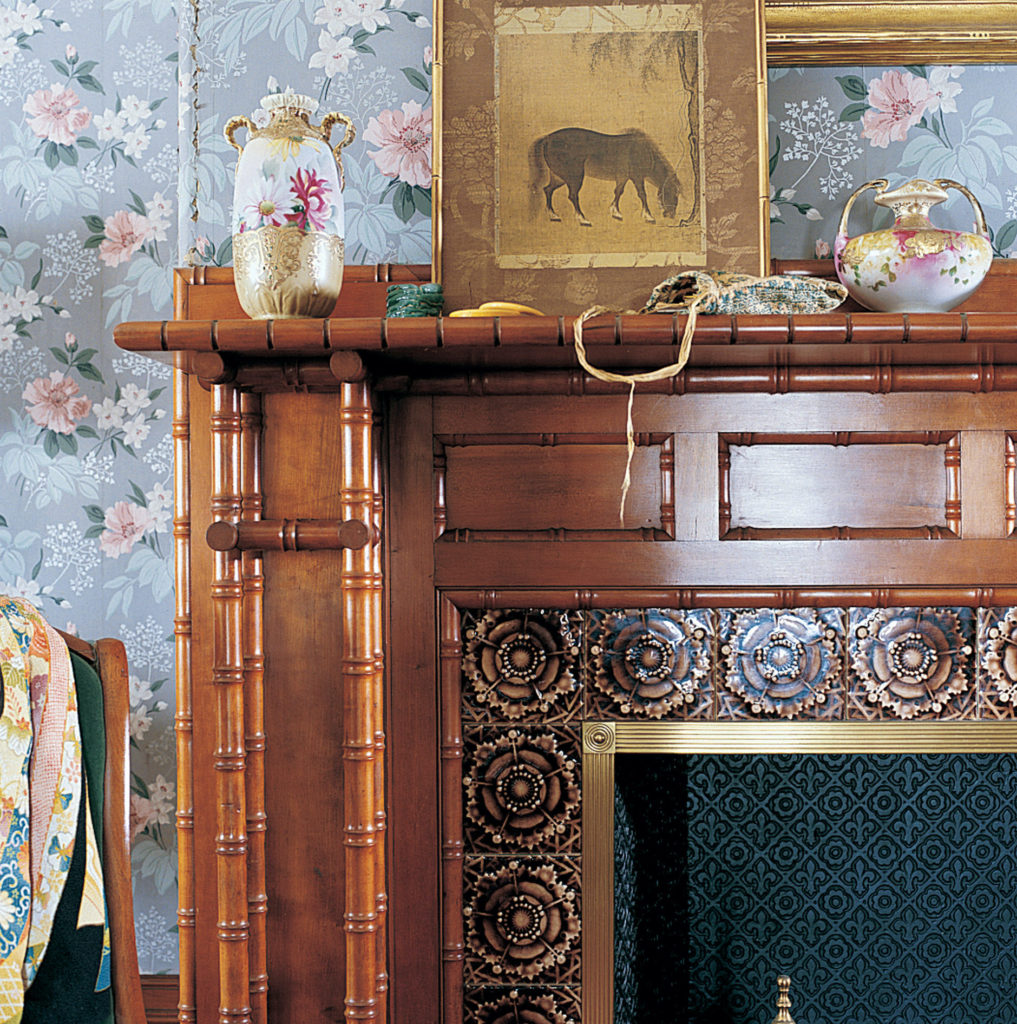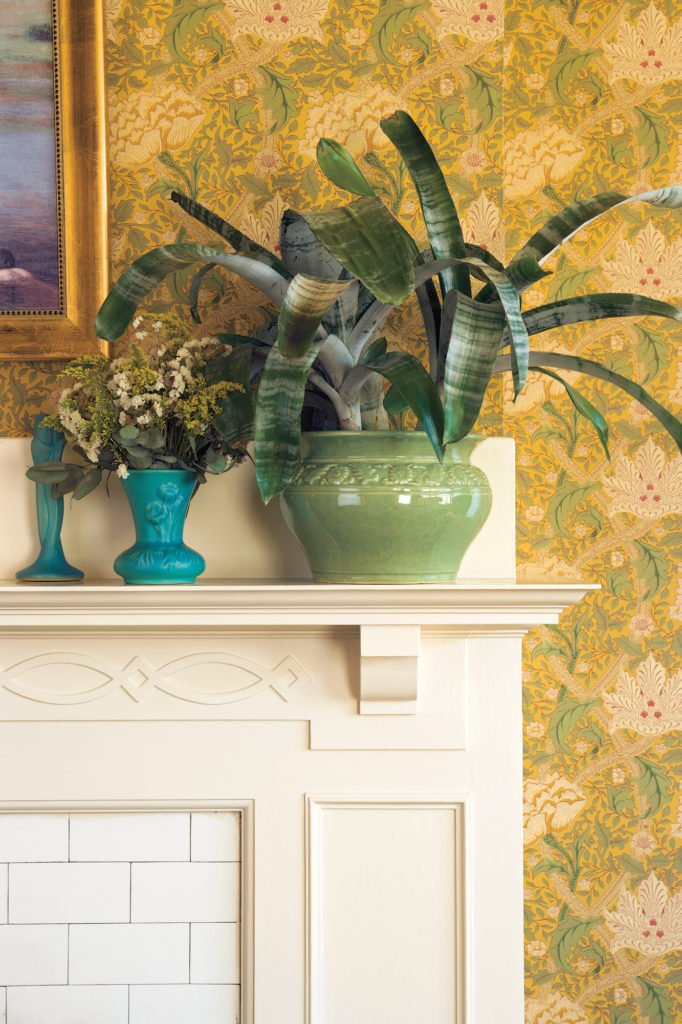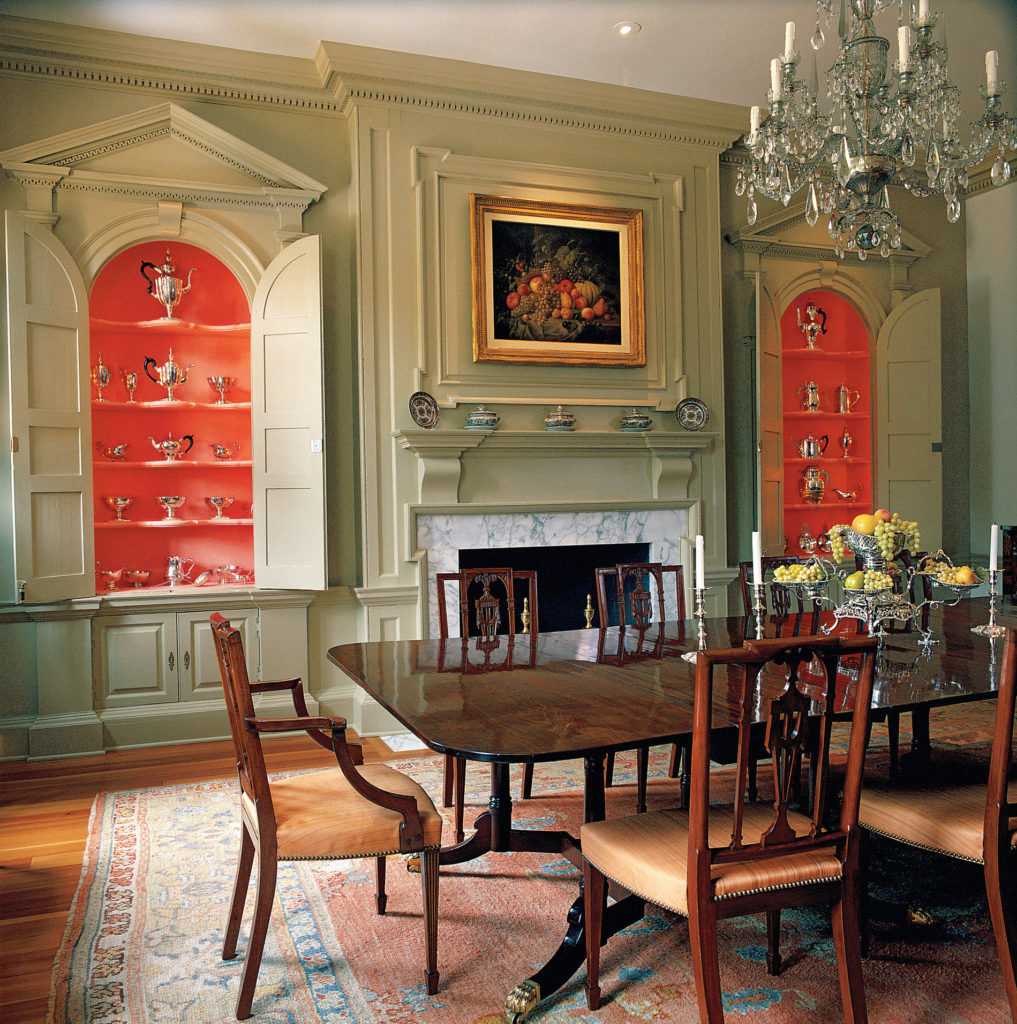A mantel or mantelpiece is the decorative frame for the fireplace opening, usually with a shelf above the firebox. The surround is the material between the firebox and the mantel—heatproof stone, concrete, tile, or brick. American houses of the wealthy had elaborate, carved mantels as early as the mid-1700s.
In an 18th-century Massachusetts house, the highlight of a parlor added in the 1780s is a beautiful, hand-carved mantel in fine Federal style. Note the delicacy of mouldings, dentils, and ornament. The rosette frieze is repeated in the chair rail. Edward Addeo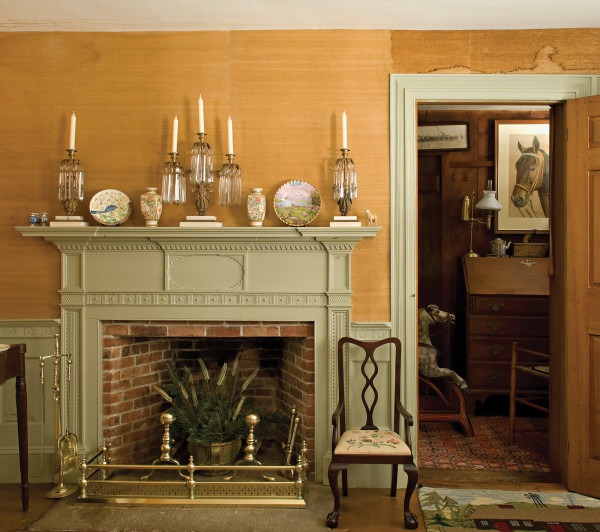
After the Revolution, decorative mantels were popularized through builders’ pattern books published in London and America. Lighter than their robust Georgian precedents, these mantels interpreted the neoclassical designs of Robert Adam (thus the alternate name “Adamesque”). This era’s neoclassical wave was called the Federal style in this country. Composition ornament (applied urns, swags, and flowerpots) was already available, though mantels were also carved entirely of wood, like those by Samuel McIntire in
Salem, Massachusetts. By the 1820s, the Greek Revival style was ascendant, and with it came a plain, structural rather than refined style.
A not-atypical 1890 mantelpiece in red birch, in a house in Peoria. Gross & Daley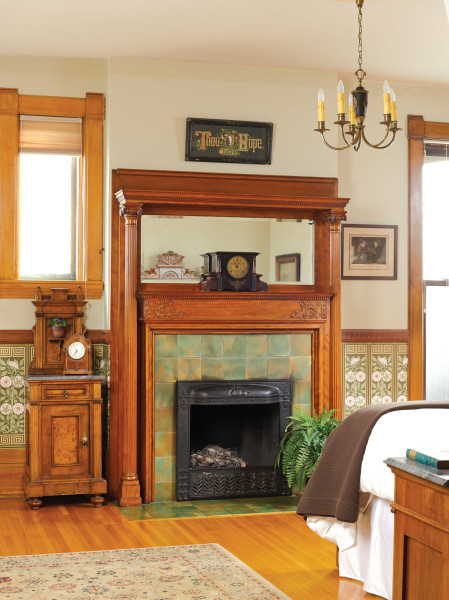
By the mid-19th century, some fireplace surrounds/mantels actually were made of marble, or of slate painted in imitation of marble. The style progression continued in the years before the Civil War, embracing the Gothic Revival and Renaissance Revival styles. Throughout the decades, design motifs were interpreted differently in rural homes and high-style urban ones.
THE ART OF PROPORTION
Study fireplaces from your period or in the neighborhood to get a sense of relative sizes for the surround, mantel, and any related ornament or woodwork. A prefab mantel will fit many houses built in the 20th century. Older houses—and when you want a specific design—call for custom work. Your architect or contractor can help, and millworks suppliers will create a moulding package to create a wood mantel. (See mantel specs and classical-moulding catalogs at kuikenbrothers.com) A salvaged mantel, well chosen, will be period-appropriate and may be a bargain if it has carvings. Installation may be tricky, especially if the mantel or surround needs modification for fit and fire-code compliance. Just be sure you won’t need to cut or add too much to the mantel, as the proportions will change.
Mantel height is fairly set, with the shelf at about 52 to 58 inches above the floor. That makes a statement in a room with an eight-foot ceiling. In a high-ceilinged Victorian room, the mantel is not necessarily taller or bigger; proportions are enhanced by the treatment of the overmantel area and wall divisions, such as a frieze or cove near the ceiling. (Exceptions are many, but proportion and scale remain critical.) Be sure the width and projection of the mantel don’t interfere with door openings. Mock up the proposed mantel in the room, using cardboard or wood scraps.
Turkish seating and an ebonized Bugatti table flank the original fireplace with overmantel. Bird’s-eye maple is featured in much of the woodwork. Eric Roth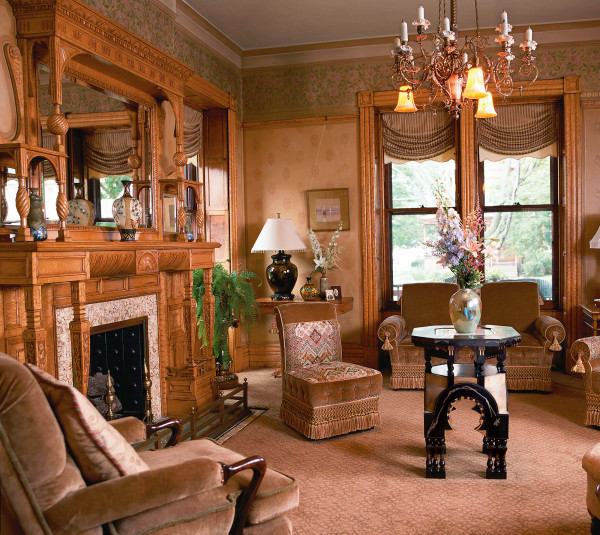
Classical proportions are a starting point. That is, the mantelpiece should correspond to the classical orders in terms of plinth (base), leg (pilaster) height, head (entablature) depth, and so on. Fireplaces of the Arts & Crafts era are a separate study, as so often the surround is more prominent than the mantel, and the mantel is tied to flanking bookcases or seats by continuous wood trim. Study period examples on house tours and in books. Note how dramatically woodwork profiles and mouldings change with era and style.
A mantel should not be shorter than the width of the fireplace including the hearth. A wood mantel must be at least six inches from the firebox, and should extend a minimum of three inches beyond the surround. The mantel overlaps the surround. The entablature (head, lintel, or frieze) below the shelf and its bed moulding should be deeper than each leg is wide. Mantel legs resting on the hearth look better and meet modern fire codes.
An 1811 country mantel with little ornamentation nevertheless has fluted pilasters and dentil moulding. Eric Roth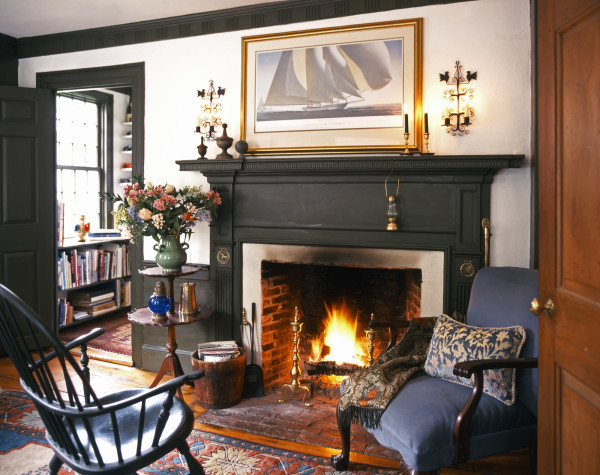
If all you’re doing is refacing the surround and installing a new wood mantel, without demolition or change to the firebox, this can be a do-it-yourself job. Any masonry and tiling is tricky, though, and you want to be sure everything follows modern fireplace codes.
Fireplace Surrounds
A wide brick fireplace, 1907, is given breadth by matching bookcases. TJ Pignataro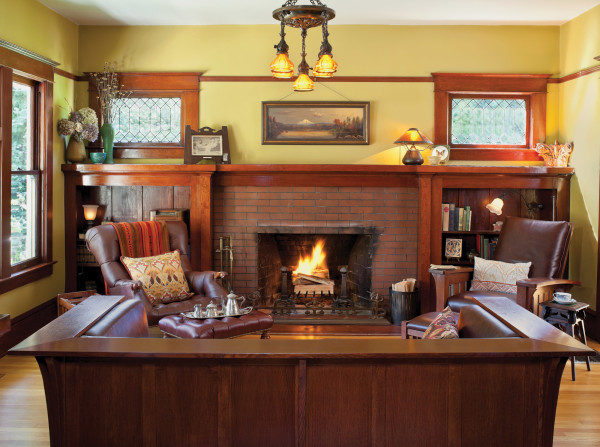
The narrow header and legs earlier surrounding the firebox gave way to heatproof facings for Craftsman and Rustic houses; the surround, mantel, and even shelf might be done in a single material: brick, stone, or tile.
An almost identical pairing appeared in Morgan Woodwork’s “Building with Assurance” catalog of 1921.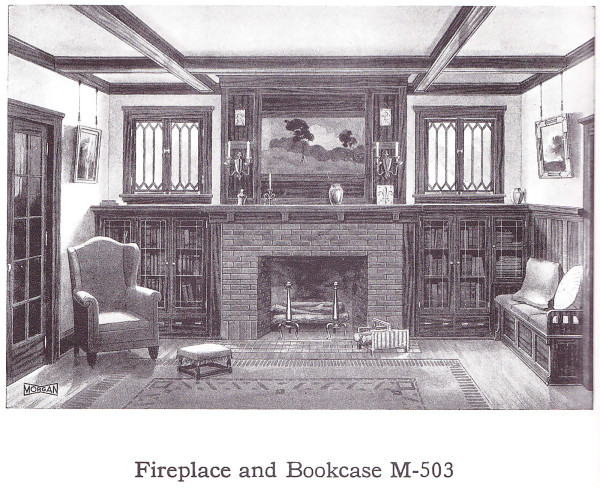
Anatomy of a Fireplace
Parts of a mantelpiece are labeled on this drawing of the formal Georgian fireplace in the West Parlor at Washington’s Mount Vernon. Not every mantel has an overmantel, which may end with crown moulding at the ceiling. The surround and mantel itself vary in size and proportion by style.
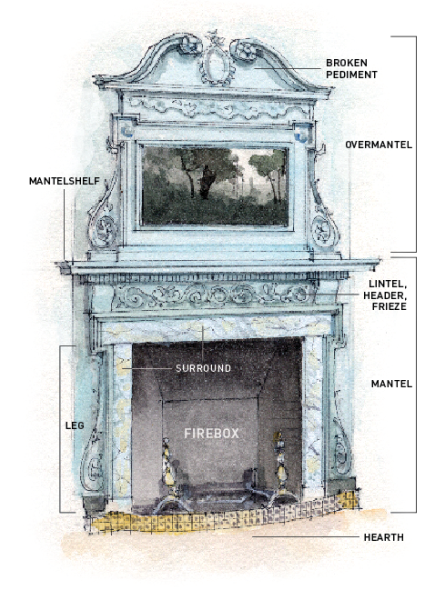
Rob Leanna
Sizing It Up
Proportion is different from scale, and both are important. Scale relates to both the actual and relative size of a piece in the room. Proportion deals with the relationships among various elements. You can have a well- proportioned mantel that is simply too big for the room (over-scaled). More likely, you’ll encounter reasonably scaled mantels with distorted proportions, like a too-narrow header.
Mid-Victorian ca. 1850–1875: Increasing wealth and trade-happy empire building meant there was a lot of stuff. A romantic oil painting is the backdrop for a gilded figural Continental clock under a glass dome, blue Minton vases, brass figural candlesticks, fairy lamps with Burmese art-glass shades, and a polychromed cigar lighter. Linda Svendsen archive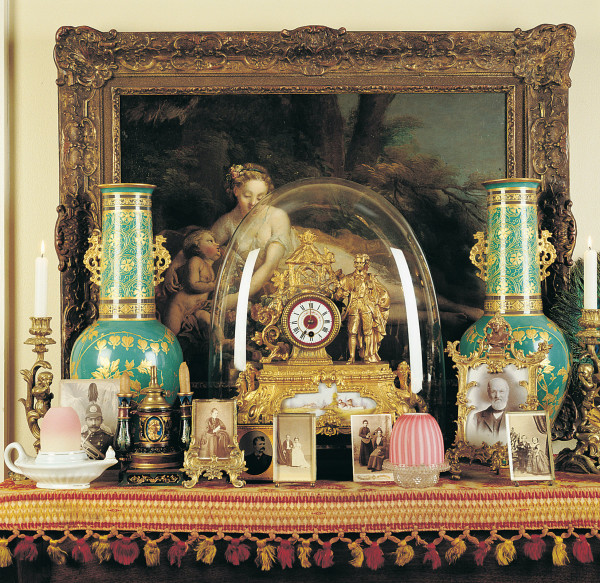
Mantelscapes
Bring out the inherent (or preferred) style of your bungalow or Colonial Revival house with a well-dressed hearth and mantel.
An original fireplace is an important element of style. Its design is a clue: Does your house lean toward late Victorian (spindles on an oak over-mantel), Craftsman (beveled mirror and ochre art tiles), Mission or Spanish (black iron sconces), Prairie (Roman-brick wall with stone header), Tudor (an arch), or Colonial Revival (white paint and swags)? If it’s as obvious as those examples, choose appropriate fireplace accessories and decorative objects to avoid muddling the point. If your fireplaces are plain and mundane, use accessories and objects to make a style statement in concert with the house.
Over the mantel Traditional options for the wall over the mantel include artwork, a mirror, taxidermy, or a textile. In the first quarter of the 20th century, art was often a plein-air or landscape painting, a portrait, or such period favorites as Edward Curtis prints of Native Americans. When a mirror was used, often it was beveled glass set into mouldings over the hearth, rather than a florid piece hung on the wall, as in previous periods. Animal heads continued to be popular in Western and Rustic homes or dens.
The Arrangement
Objects on display often look best if they trace a V (tall, low, or inverted) or a W. Find balance without symmetry in the volume of objects.
The mantelshelf Objects of great variety were displayed on the mantel during these years: travel photos in frames; pottery; candlesticks; vases with or without flowers; leather-bound books; framed art tile; antique ceramics;, collectibles such as boxes, glassware, silver, and pewter; small statues; and finds from nature—a bird’s nest, a branch or driftwood, pinecones, seashells. The style and degree of formality in your house will guide you. Choose a theme, and remember that Victorian clutter had become outmoded.
The arrangement itself helps define your style. Colonial Revival displays are symmetrical, sometimes obsessively so. Arts & Crafts arrangements sometimes use symmetry, as well, but often have an unstudied feeling with asymmetrical placement of objects—but balanced, of course. Finish the look with appropriate iron or brass fireplace tools.
Many houses ca. 1890–1925 exhibit a melding of Elizabethan and Jacobean, Reformed Gothic, English Arts & Crafts, and Tudor Revival forms. All of these revivals had roots in late- and post-Middle Ages England. William Wright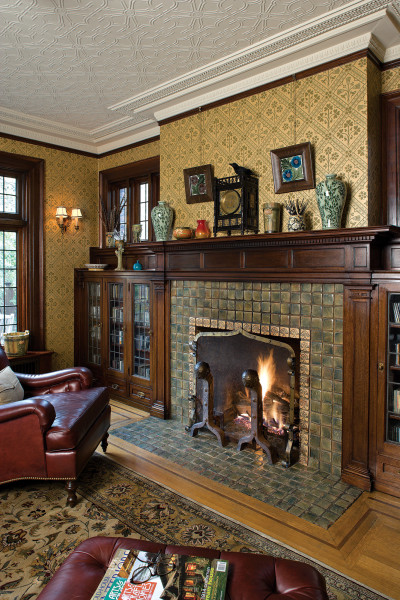
man·tel | man-t•l: the decorative frame around the firebox and the surround. It may be of wood, marble or other stone, or metal. The word also may refer to the entire mantelpiece or to the mantelshelf. In the bungalow era, mantels are often one with a brick or tile surround.
Mantel Styles by Era
The progression of styles is fluid, with overlaps and time delays outside of urban areas. Colonial (Georgian) raised-panel fireplace wall treatments appear in houses built as late as 1840. A prefab mantel ordered from a catalog may not be in sync with other elements of a 1920s house.
GEORGIAN Distinctive of the classically proportioned Georgian fireplace is its overmantel treatment, often topped with a broken pediment. A bed moulding with egg-and-dart, dentil, or other detailing supports the mantelshelf.
ADAM/FEDERAL Adamesque or Federal-era mantels feature low-relief carved and reeded ornament such as scrolls, urns, flowers, eagles, and mythological figures. By 1800, the broken pediment had disappeared. Overmantels were scarce.
GREEK REVIVAL These mantels are usually based on the plain, post-and-lintel construction of Greek temples. White marble is the height of Athenian splendor, but most American Greek Revival mantels are of wood, sometimes faux-painted with veining.
GOTHIC REVIVAL These mantels accentuate the perpendicular. The firebox opening or overmantel typically features a pointed Gothic or shallow Tudor arch.
ROCOCO Many mid-19th-century marble mantels have an arched firebox opening. The spandrels forming the arch often overflow with carved fruits, leaves and flowers, or cherubic figures in three-dimensional relief. Wood mantels are carved.
RENAISSANCE REVIVAL Formal, delicately carved mantel-pieces once again are likely to include an overmantel.
AESTHETIC/EASTLAKE With influences from medieval to Turkish to Japanese, the mantel proper may be flat with minimal decoration, while the overmantel is an elaborate construction of shelves, mirrors, and niches for the display of worldy objets d’art.
ARTS & CRAFTS The quintessential bungalow mantel is brick or local stone, sometimes inset with handmade tiles. But Prairie School mantels are modern, usually constructed all in masonry, with bold designs, such as a semi-circle arch.
REVIVALS The most widespread designs of the early 20th century are Colonial Revival. Wood is often painted in an off-white color. Various arch shapes define Tudor Revival and Spanish Colonial Revival mantels.
Mantel Beauty
Antique, vintage, and reproduction fireplace mantels and accessories are available for your new construction or to enhance an existing fireplace.
The ‘Farmington’.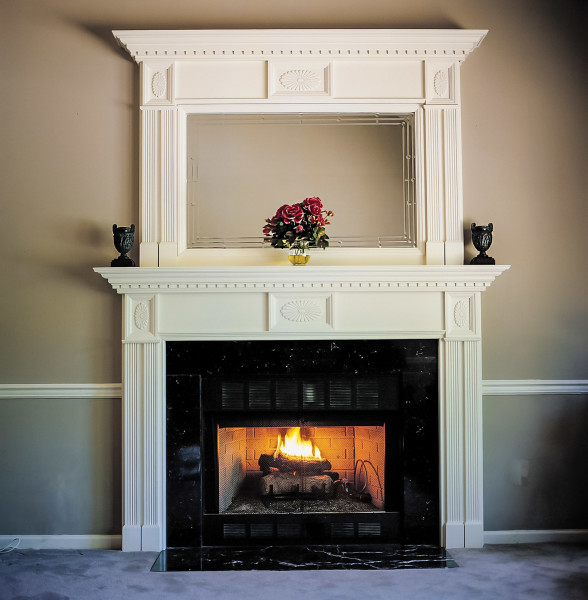
A Colonial Revival classic, the ‘Farmington’ comes in standard and custom sizes. Shown in white paint on poplar, it’s available in pine, maple, oak, or cherry for staining and natural finish. Easy to install, starting at $900 (overmantel sold separately). Find surrounds, stone facing kits, gas and electric fireplaces, and accessories at mantelsdirect.com
Ornamental mantel.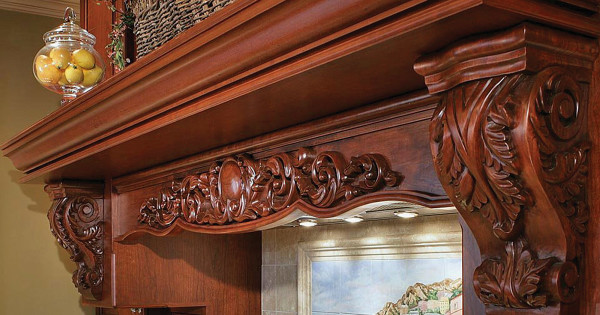
Decorators Supply sells such components as corbels, plinth blocks, and ornamental compo onlays as well as finished wood mantels and shelves. Furniture-quality custom mantels in Georgian, French, and Adam styles; see too the White River line of carved lindenwood mantels in stock sizes. Prices range from $2,800–3,200 and up. decoratorssupply.com
Glass dome or cloche.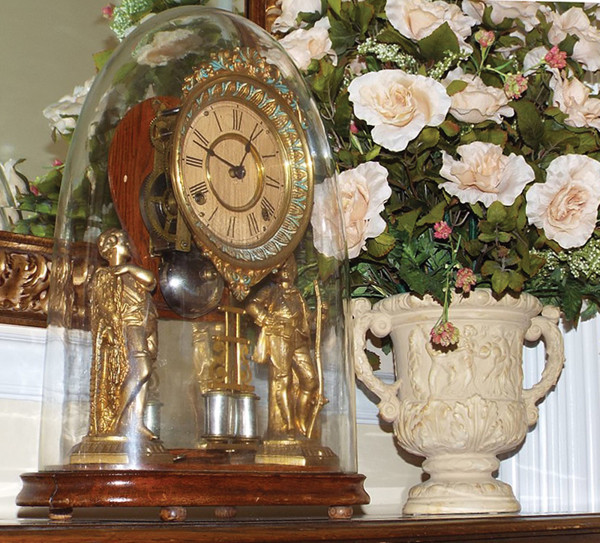
Show off a collectible, sculpture, or taxidermy in a glass dome or cloche on your Victorian mantelshelf. This company inventories new (hand-blown) and antique domes—round, oval, and rectangular—and matching bases in wood, marble, or brass. Pricing by size and rarity; a new oval glass dome 16.75″ tall costs about $325. glassdomes.com
Victorian-style gas insert.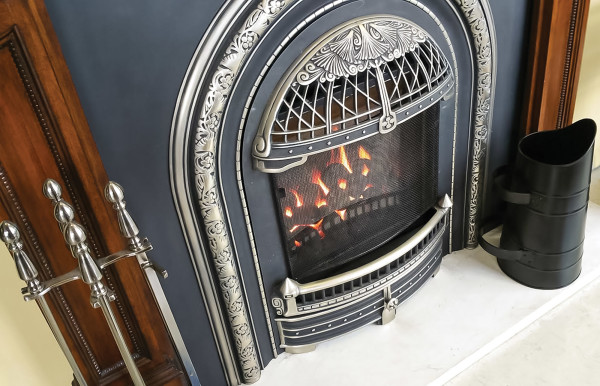
The Victorian Fireplace Shop’s English Victorian-style gas insert is shown with a screen and coal scuttle. Find everything for upgrades or new fireplaces, with a specialty in smaller and historic fireplaces. A ‘Windsor’ small gas insert is $3,798. victorianfireplaceshop.com
Craftsman-style mantel clock.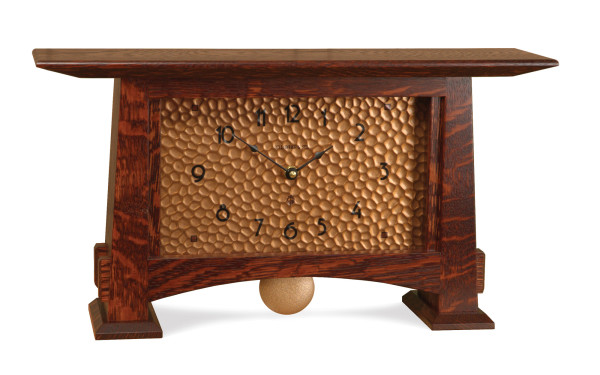
Handcrafted by Schlabaugh and Sons in Iowa, this Craftsman-style
mantel clock is made of quarter-sawn white oak and finished in a rich, deep stain. Under a glass lens, the dial is solid copper. The clock
measures 18″ wide x 10″ tall x 5″ deep, $383. schsons.com



